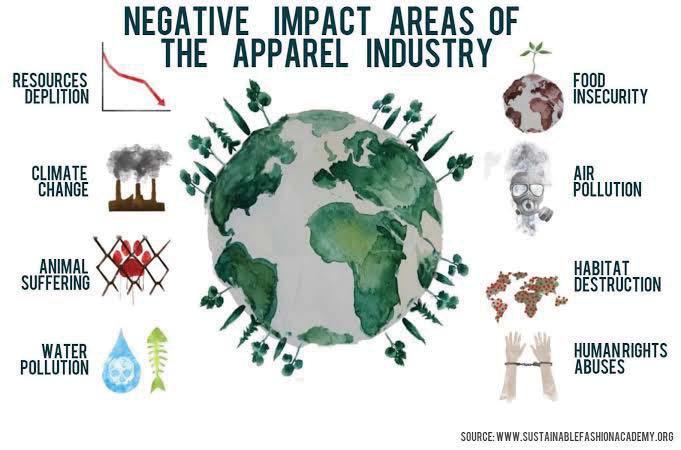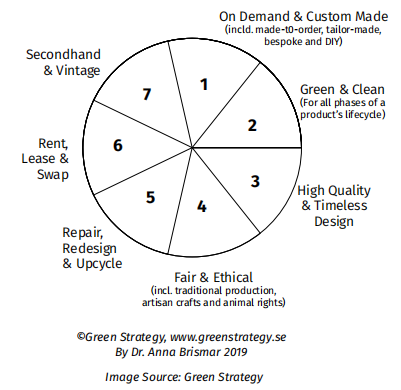The fashion industry is slowly and steadily inching towards creating conscious fashion. In 2018, fashion stakeholders, under the patronage of UN Climate Change, worked to find ways in which the textile, clothing and fashion industry can adopt a holistic commitment to climate action. This has led to the creation of the Fashion Industry Charter for Climate Action, containing the vision to achieve net-zero emissions by 2050…
What is sustainability and why is it a big deal? What is the impact of sustainability in fashion?
Sustainability as a term was referred in 1972 at the UN Conference on Human Environment held in Stockholm and was mentioned as a solution to environmental issues in 1987 at the Brundtland Commission. It also formed the basis of United Nations conference on Environment and Development held in Rio di Janeiro in 1992 wherein world leaders acknowledged as a major challenge.
 Where does the fashion industry fit into the sustainable spectrum? As per an article published on Global News, some of the statistics of the production cycle are as follows: “the average T-shirt uses seven to 10 full bathtubs of water; a pair of jeans uses about 6,800 litres of water; the fashion industry uses 1,600 chemicals in their dyeing processes; a T-shirt can travel up to 3,500 km before it lands on a consumer’s back.” As per an EU report published in January 2019 stated that only one percent of used clothes are recycled into new clothes. Whereas, the majority ends up in landfill or is burnt, increasing the carbon footprints.
Where does the fashion industry fit into the sustainable spectrum? As per an article published on Global News, some of the statistics of the production cycle are as follows: “the average T-shirt uses seven to 10 full bathtubs of water; a pair of jeans uses about 6,800 litres of water; the fashion industry uses 1,600 chemicals in their dyeing processes; a T-shirt can travel up to 3,500 km before it lands on a consumer’s back.” As per an EU report published in January 2019 stated that only one percent of used clothes are recycled into new clothes. Whereas, the majority ends up in landfill or is burnt, increasing the carbon footprints.
The collapse of Rana Plaza factory building in Dhaka that left 2,500 injured and 1,134 killed housed some of the biggest brands in fashion. Garment workers in factories have to not only endure low wages but also abuse and poor working conditions. Demand for animal products has led to slaughtering of a number of animals and also endangered species.
Positive change is the need of the hour than ever before, with mounting human rights violation within the fashion industry and environmental dilapidation. It is imperative to tackle climate change and create a fairer future for everybody working and associated with the fashion industry.
The fashion industry is slowly and steadily inching towards creating conscious fashion. In 2018, fashion stakeholders, under the patronage of UN Climate Change, worked to find ways in which the textile, clothing and fashion industry can adopt a holistic commitment to climate action. This has led to the creation of the Fashion Industry Charter for Climate Action, containing the vision to achieve net-zero emissions by 2050.
Fast fashion giant, H&M too has taken steps towards incorporating sustainable and ethical fashion. It’s ethical fashion brand, “Conscious Collection” is made from organic cotton and recycled polyester.
In order to promote sustainability, it is imperative to develop a sustainable supply chain at each stage – from material production, garment manufacturing, transportation, distribution, consumer education to retailing. Take for example a brand like Mango. It features a Committed Collection made from certified organic and recycled cotton, recycled polyester or cellulose-based fabric Tencel. The company is also working on developing methods to calculate its water footprint and identify water-saving potential, which will help it reduce water consumption. Front lining this revolution is the pioneer of alternative materials,Stella McCartney, who has been reshaping the fashion industry since the inception of her first collection. To foster a conscious social and environmental impact in the fashion industry, Stella McCartney regularly conducts audits and measures impact.
M&S was one of the first mass-market company to create transparency in its supply chain by incorporating its factory map on its website, that informs what happens where in the world for many of its categories, including clothing, homeware and food. According to the Global Fashion Agenda (GFA), 12.5 percent of the global fashion market, including big names like Nike, Adidas, Levi’s and Gap, have signed up to 2020 sustainability targets, which include publishing lists of all the suppliers producing for them.
 Fast fashion giant, H&M too has taken steps towards incorporating sustainable and ethical fashion. It’s ethical fashion brand, “Conscious Collection” is made from organic cotton and recycled polyester. In order to build transparency, the brand also launched an annual sustainability report. It also a part of the garment collection program wherein the consumer can drop unwanted and used clothes in a recycling box at the nearest local store which is then sent to the nearest recycling plant.
Fast fashion giant, H&M too has taken steps towards incorporating sustainable and ethical fashion. It’s ethical fashion brand, “Conscious Collection” is made from organic cotton and recycled polyester. In order to build transparency, the brand also launched an annual sustainability report. It also a part of the garment collection program wherein the consumer can drop unwanted and used clothes in a recycling box at the nearest local store which is then sent to the nearest recycling plant.
Another way to practice sustainability is through the practice of nearshoring which brings production closer to home base and invest in advanced manufacturing, less waste along with reduction of overproduction. This practice will decrease the ecological footprint from reduction of transport.
The onus of imbibing a conscious adoption of sustainable practices does not lie entirely with the fashion industry; consumers too can be contributors towards creating a sustainable approach. The below diagram was created by Dr Anna Brismar highlights seven forms of sustainable and circular fashion.
 The diagram is from the perspective of the consumer and producer. 1) At the manufacturing stage the garments should be custom-made in 2) high quality and timeless design, 4) in a fair and ethical manner. Once the garment is created it should be used well 5) with good care, repair and perhaps redesign. 6&7) When the garment/product loses its appeal is should be handed over to a relative or friend, sold to a second-hand shop or donated to delay its life. When the garment/product wears out completely, it can be dropped to retail stores part of garment collection program.
The diagram is from the perspective of the consumer and producer. 1) At the manufacturing stage the garments should be custom-made in 2) high quality and timeless design, 4) in a fair and ethical manner. Once the garment is created it should be used well 5) with good care, repair and perhaps redesign. 6&7) When the garment/product loses its appeal is should be handed over to a relative or friend, sold to a second-hand shop or donated to delay its life. When the garment/product wears out completely, it can be dropped to retail stores part of garment collection program.
What will happen to the designer or manufacturing/production units that thrive on creating products to make profits? Well to answer the question, in a report released by Dame Ellen MacArthur, DBE is a retired English sailor – ‘A New Textiles Economy: Redesigning fashion’s future’ along with Stella McCartney, in their interview with BBC Newsnight stated, “Rather than looking at it as a problem, we need to look at it as an opportunity. It is a 500-billion-dollar opportunity if we can get this right. We can keep the fashion cycling for longer if we can recover that material.”



